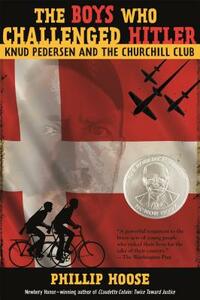You need to sign in or sign up before continuing.
Take a photo of a barcode or cover
History, adventure, first person accounts, engaging informational text. Let a little child lead them... the Danish Resistance during WWII didn't get started until these teenagers stepped up and started harassing the German occupying troops. The teens exhibited great courage and typical teenage spontaneity guided their actions. Looking forward to book talking this title.
BOOKTALK: Knud Pedersen was ashamed of his home country of Denmark. When the German's moved in, no one, not the government, not the military, not the citizens resisted. Angry, Knud joined with his brother and some classmates to take action against the Nazis. Together they sabotaged vehicles, stole weapons, burned buildings and left a graffiti symbol on their work. Infuriated the Germans insisted that the Danes fine the perpetrators and punish them. But this did not stop the boys. A true adventure story told through the eyes of Knud,
BOOKTALK: Knud Pedersen was ashamed of his home country of Denmark. When the German's moved in, no one, not the government, not the military, not the citizens resisted. Angry, Knud joined with his brother and some classmates to take action against the Nazis. Together they sabotaged vehicles, stole weapons, burned buildings and left a graffiti symbol on their work. Infuriated the Germans insisted that the Danes fine the perpetrators and punish them. But this did not stop the boys. A true adventure story told through the eyes of Knud,
This was a really well written book on an aspect of World War 2 that you don't hear much about in YA fiction. The narrative flowed through the whole book, both with the action of "what were the boys going to try next?" and "would they get caught this time?" The sidebar notes were interesting and helped give context on lesser known people/events.
I think there are a lot of teens that would like this one, it shows that people their age can make a difference, even if there are consequences for their actions. I find that many of them seem to gravitate more towards historical non-fiction when there is action involved in the narrative (this would be a great read alike for the teens who loved Bomb by Steve Sheinkin....it's the same action oriented historical narrative). With the passing away of so many of the participants, this is a story that almost didn't get told for this age group (at least not with interviews from people who actually lived it).
I think there are a lot of teens that would like this one, it shows that people their age can make a difference, even if there are consequences for their actions. I find that many of them seem to gravitate more towards historical non-fiction when there is action involved in the narrative (this would be a great read alike for the teens who loved Bomb by Steve Sheinkin....it's the same action oriented historical narrative). With the passing away of so many of the participants, this is a story that almost didn't get told for this age group (at least not with interviews from people who actually lived it).
An excellent addition to my growing arsenal of YA Nonfiction!
This is the story of the earliest Danish resistors of the Nazi occupation during the second World War - and what's special about them is that they were (mostly) a group of teenagers! This little-told tale follows Knud Pedersen (the founder and later spokesman) and the rest of the Churchill Club from their first exploits spinning signposts, through their more dangerous missions involving arson and theft, all the way up to the end of the war and the consequences of their actions both for themselves and for Denmark as a whole.
The book itself is a page-turner - you always want to find out what happens next! Will they be caught? What do their fellow Danes think of these boy saboteurs? Does Churchill himself approve of the Churchill Club? What happened after the war?
All in all, this is a great book to have on hand for any student that isn't so sure about how nonfiction could be interesting.
This is the story of the earliest Danish resistors of the Nazi occupation during the second World War - and what's special about them is that they were (mostly) a group of teenagers! This little-told tale follows Knud Pedersen (the founder and later spokesman) and the rest of the Churchill Club from their first exploits spinning signposts, through their more dangerous missions involving arson and theft, all the way up to the end of the war and the consequences of their actions both for themselves and for Denmark as a whole.
The book itself is a page-turner - you always want to find out what happens next! Will they be caught? What do their fellow Danes think of these boy saboteurs? Does Churchill himself approve of the Churchill Club? What happened after the war?
All in all, this is a great book to have on hand for any student that isn't so sure about how nonfiction could be interesting.
Powerful history we would do well to remember. It speaks to the power of youth, the power of solidarity, the importance of resistance, and the ways small actions can cause ripple effects that can bring about a revolution.
This was a random grab at a library sale (for my Little Free Library). I checked Goodreads and saw the ratings were good. I figured I'd give it a quick read before letting it go. As I'm a digi-girl, I grabbed the audio and kindle copies, easily available from the library.
Phillip Hoose is the author, and he has 3rd person(past tense) portions giving background to the situation, then shifts to Knud Pedersen, not listed as an author, but written (and narrated) as straight from his mouth (1st person/past tense). In the audio, they had two narrators to differentiate (which I appreciated).
The physical/Kindle copies also have quite a few illustrations. Maps, photos, notes, etc. Also sections where the text is set apart. While the audio was good/fine, I wonder if a text copy is the way to go (or both, as I often do). There was a little song/lyrics ... just spoken in audio. Also, as often happens in Audible books (I didn't double check Libby/Hoopla) but this had an intro (part of the story, I fear people skip "intros") which is listed as Chapter1, which then throws everything off, (chapter 1 is then listed as chapter 2 in the audio TOC).
There was a "Notes" section which further clarified Knud's first person account (taken from interviews and emails and Knud's earlier published writings). I always find it interesting to have any and all information on the background/creation of the book, what is fact, etc. There was a full bibliography as well. Taking into consideration how an individual's memory may not be exact, I thought the documentation and presentation here was top notch.
There are SO MANY WW2 books, from different perspectives, countries, peoples. I feel like there's always a little more to learn. Here I think the main take-away for me was how Denmark and Norway handled the invasions (Denmark accepting it, much to the dismay of many, and Norway fighting), and how some people (kids) stepped up anyway. A lot of it was narrative/informative, but it was enough of a story to keep my attention. My boys are older now, but this is one I definitely would have recommended if they'd had to read a book for school (and could choose).
I don't know if I will put this in the little library after all ... I think I might add it to my personal collection.
Phillip Hoose is the author, and he has 3rd person(past tense) portions giving background to the situation, then shifts to Knud Pedersen, not listed as an author, but written (and narrated) as straight from his mouth (1st person/past tense). In the audio, they had two narrators to differentiate (which I appreciated).
The physical/Kindle copies also have quite a few illustrations. Maps, photos, notes, etc. Also sections where the text is set apart. While the audio was good/fine, I wonder if a text copy is the way to go (or both, as I often do). There was a little song/lyrics ... just spoken in audio. Also, as often happens in Audible books (I didn't double check Libby/Hoopla) but this had an intro (part of the story, I fear people skip "intros") which is listed as Chapter1, which then throws everything off, (chapter 1 is then listed as chapter 2 in the audio TOC).
There was a "Notes" section which further clarified Knud's first person account (taken from interviews and emails and Knud's earlier published writings). I always find it interesting to have any and all information on the background/creation of the book, what is fact, etc. There was a full bibliography as well. Taking into consideration how an individual's memory may not be exact, I thought the documentation and presentation here was top notch.
There are SO MANY WW2 books, from different perspectives, countries, peoples. I feel like there's always a little more to learn. Here I think the main take-away for me was how Denmark and Norway handled the invasions (Denmark accepting it, much to the dismay of many, and Norway fighting), and how some people (kids) stepped up anyway. A lot of it was narrative/informative, but it was enough of a story to keep my attention. My boys are older now, but this is one I definitely would have recommended if they'd had to read a book for school (and could choose).
I don't know if I will put this in the little library after all ... I think I might add it to my personal collection.
adventurous
hopeful
inspiring
medium-paced
Although I am not much of a fan of nonfiction books, I have to say I enjoyed this one. I've always been interested in World War II and it is nice to see a new point of you. I would definitely recommend this book to fiction and nonfiction readers alike. I think my middle school or's will enjoy it.
Interesting story about teens who began the Danish resistance to the Third Reich. Hoose excels at these kind of books - he provides lots of accurate information in format that readers find comfortable. Lots of good photos are included. He was profoundly lucky that Knud Pedersen was still alive and could provide the details. Why the Nazis didn't just execute them will always remain a mystery.
Give to kids who like WWII history and they will gobble it up.
Give to kids who like WWII history and they will gobble it up.
I liked the narrative style of this book and learned a lot about a topic I had previously never heard of. The





